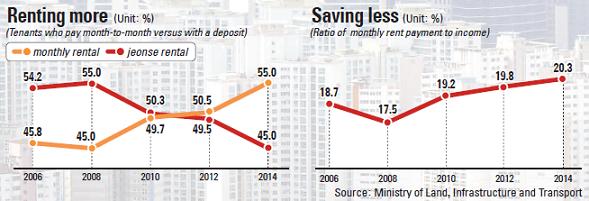Rentals more popular than jeonse

Monthly rentals took 55 percent of the entire rental housing market, up five percent from 2012, according to an annual report on the country’s residence conditions for 2014 released Wednesday by the Ministry of Land, Infrastructure and Transport.
The rate of jeonse houses dropped to 45 percent, from 49.5 percent in 2012. That year, the monthly payment system surpassed the jeonse system in popularity for the first time in the previous decade.
Monthly rental houses accounted for 23.2 percent of all residences, increasing from 21.3 percent two years ago. Jeonse houses fell 1.9 percent to 19.6 percent in the same period.
The increase in monthly rentals came as the Bank of Korea lowered its key policy rate twice in 2014, from 2.5 percent to 2.25 percent in August and down to 2 percent in October 2014, the lowest ever at the time.
The central bank once again cut the base rate to the historic-low 1.75 percent in March this year.
The plunge led to falling deposit rates at local banks in Korea. That made many landlords demand monthly rent fees, rather than a lump sum they could deposit into their accounts.
As a result, the ratio of monthly payments to monthly income among renters rose to 20.3 percent from 19.8 percent over the past two years.
As the number of jeonse rental houses is becoming scarce and the average key money for jeonse houses is skyrocketing, many tenants are rather choosing to purchase their own houses, benefitting from the low interest rate.
The statistics released by the Land Ministry on Wednesday showed the average time taken by householders to purchase their houses after becoming the head of their family - usually after getting married - shrank to 6.9 years in 2014, from 8 years in 2012.
However, the statistics also showed that there was polarization among home buyers with differing incomes.
According to the report, 77.7 percent of people in the top-10 percent income bracket - earning more than 4 million won ($3,650) per month - also owned their own home in 2014, up from 72.8 percent in 2012.
However, only 50 percent of people with low incomes - less than 2 million won per month - owned their own home, down from 52.9 percent.
For middle-income earners - between 2 million won and 4 million won per month - 56.4 percent were homeowners, down from 56.9 percent.
In Seoul, many tenants are also turning to buy units in multifamily houses, which are cheaper than residential houses requiring jeonse key money, other statistics showed.
According to the Seoul city government, that the number of multifamily houses sold in Seoul was 11,372 between January and March in 2014, a 31.1 percent of increase from the first quarter in 2013.
The record was the highest since 2008, when a total of 16,873 multifamily houses were sold in the capital.
In March, the number of home sales reached 111,869, its highest level since the Land Ministry started to collect the data in its current form in 2006.
The ministry said that the increase in home sales was mainly boosted by the spike in sales of non-apartment houses, such as multifamily houses, single-family houses and studios for individual households.
In fact, statistics by the state-run Korea Appraisal Board show that the average price of multifamily houses in Seoul was about 3.9 million won per square meter (10.8 square feet), only about 133,000 won more than the average jeonse price of residential apartments in Seoul, 3.8 million won per square meter.
“As many tenants are facing demand from landlords for monthly payment, they are choosing to buy multifamily houses, because they can add only a small amount of loans to their jeonse key money to purchase them,” said Kim Eun-jin, a real estate specialist at Budongsan114, by phone.
“Some real estate investors also bought multifamily houses so that they can earn monthly payments from tenants there.”
BY KIM HEE-JIN [kim.heejin@joongang.co.kr]










with the Korea JoongAng Daily
To write comments, please log in to one of the accounts.
Standards Board Policy (0/250자)